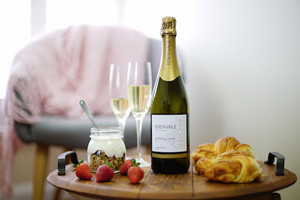
The lagoon was pulsating with golden, transparent jellyfish and, at first, I couldn’t believe I was actually snorkelling among them, let alone touching them. I’d seen it done in episode six of “Survivor Palau” back in 2004, but there’s quite a difference between watching something on television and doing it for real. The idea of immersing myself into a lake teeming with jellyfish made me nervous. These fascinating animals are the bane of swimmers and surfers across the globe; I, too, have had my fair share of painful welts after a close encounter with a bluebottle while swimming back home in eastern Australia. But as we were told, nothing in Palau is the same as anywhere else in the world, and that includes jellyfish.
Jellyfish Lake
Once a World War II battleground, Palau is now better known as a nature-lover’s paradise, both above and below the water, with Jellyfish Lake being one of its many attractions. The famous lake nestles in the heart of one of Palau’s famous Rock Islands, and to get there you traverse a steep track through dense jungle. The lake used to be a submerged reef that at one point in history rose up from the ocean and became sealed off. With no natural predators the long tentacles of the jellyfish gradually evolved into stubby fingers, and it eventually lost its ability to sting. During the day, millions of them migrate around the lake, following the sun and bobbing up to the surface occasionally to take nourishment from its rays. And luckily for us, limited numbers of visitors are allowed to share the moment with them. Their numbers and graceful fragility was impressive. Our tour guide had warned us to swim calmly and slowly among the jellyfish and not to lift them out of the water as they are easily damaged. And if we felt we had to touch them, the key word was “gentle”. As I cupped a small one in my hands, I had a surreal sense that I was in a truly special place and doing something rare which I may never do again. But that’s Palau in a nutshell - a unique slice of paradise which is memorable on every level.
Palau’s Diversity
The banana-shaped islands of Palau lie at the far western end of Micronesia in the Philippine Sea, halfway between Guam and Bali. A tightly bunched archipelago, its 200-plus islands sprawl along an ocean corridor only 32 kilometres wide. While the northern islands are volcanic and fertile, those in the south are upraised limestone coral formations - the famous Rock Islands. Less than a dozen of Palau’s islands are inhabited and barrier reefs enclose the entire chain, so if you’re looking for surf here you’ll be disappointed. The visit to Jellyfish Lake proved to be the highlight of a long day of snorkelling, which in Palau is pure sensory overload. Venturing out that morning, our guide had told us that waters are so clear in Palau you can drop a coin down to 30 metres and still tell whether it’s heads or tails. Biologists across the globe recognise this archipelago as the bulls-eye of biodiversity, and as we slipped into the warm, pale blue ocean for our first snorkel of the day, it was obvious that neither one was exaggerating. Palau’s spectacular underwater world is a meeting place for three major ocean currents, which brings abundant food supplies and a myriad of marine life into the region. As a result, it’s a diver’s paradise of spectacular coral reefs, blue holes, WWII wrecks, hidden caves, tunnels, and over 60 vertical drop-offs. Even a casual snorkel in the right spot can reveal sea turtles, manta rays, reef sharks, lion fish, moray eels, napoleon fish and occasionally dugongs.
Palau Pacific Resort
After a long day of touring, it was a relief to come to the surface, enjoy a cool drink and wind down. Our home for our stay was the luxurious Palau Pacific Resort on Arakabesang Island - only 15 minutes from the capital of Koror - and a stunning beachfront property boasting a private strip of unblemished white sand and a stunning coral reef. The resort offers spacious hotel rooms, all of which have a warm, tropical decor and all mod-cons, and views of the ocean or lush tropical gardens dotted with flowers and fish ponds. A new addition in recent years is a handful of overwater bungalows with spectacular views of the Pacific, a living area with a glass floor, and a private deck with steps down to the ocean. This is the kind of resort where you can be as active or chilled-out as you choose. There is a lineup of water sports to enjoy right off the beach, and a nature trail winding upwards through the local rainforest to a stunning lookout. And for sun lovers there are cabanas, a swimming pool, and plenty of peace and quiet. Palau’s growing reputation for excellent food can also be sampled at the resort’s full-service restaurants. But some of the best memories belong to the end of the day, sitting at the Mesekiu Water Hole, sipping a local cocktail, and watching one of Palau’s legendary sunsets slowly unfold.
Kayaking The Rock Islands
Even the most avid diver or snorkeller has to come up for air, and a kayak tour offers a different and unique way to explore some of the rock islands and secluded lagoons. As we ventured out on yet another picture perfect morning - the average temperature year-round is 30 degrees C - it was easy to see why Palau was chosen for the 10th season of “Survivor”. These jungle-topped knobs of limestone dot the waters for a 35 km stretch south of Koror. Although Palauans come here to picnic, fish and play at the weekends, the solitude can at times be so pure you imagine you've found the blueprint for Eden itself. We paddled out from Lee Marvin’s Beach, where some scenes for the 1968 film “Hell In The Pacific” were shot, our destination Risong Bay - an area of spectacular beauty teeming with marine and bird life. Every vine-covered tunnel, sea cave and lagoon was breathtaking. We visited Wreck Bay, where the rusty remains of Japanese supply ship poke through the water’s surface, and the turquoise oasis called Mandarin Fish Lake, with its stunning corals and the only salt-water waterfall in Palau. But Kingfisher Bay, a deeply hidden lagoon, rated unanimously as the most memorable. After paddling in through a narrow opening, our guide, Ding, recommended that we lie back, close our eyes and float freely - there wasn’t a breath of wind so our kayaks didn’t stray. Sooty terns (which are actually white) swooped high in the clear blue sky to a chorus of cricket chirps and mysterious cheeps from unseen creatures hidden deep in the jungle. I don’t recall exactly how long we floated there, but as we paddled out everyone was strangely silent. We had all felt it - a humbling sense of serenity amid the untouched wilderness, which lingered long after we returned to the resort.
Palau’s Mysterious History
Much of Palau’s early history is still largely veiled in mystery. The native people are believed to have migrated from Malaysia and Indonesia, and in its more recent history, Spain, Germany and Japan have all dominated Palau in succession. After WWII, the USA administered the islands - the US dollar is still local currency - but in 1994 Palau declared independence. Today, the locals appear very westernised with their casual American-style clothing and baseball caps, but most continue to uphold tradition. Skimpy beach attire is frowned upon away from the water, chewing betel nut (which makes your teeth and saliva turn blood red) remains a popular pastime, and if you visit a private home you’re expected to leave your shoes at the front door. Koror is home to two-thirds of the republic’s population and is surprisingly modern. The town focuses on a long strip you can comfortably walk in about 15 minutes. This main road is dotted with restaurants, shops, and convenience stores, and is presided over by the statue of Jesus - arms outstretched - from atop the Sacred Heart Church, reflecting Palau’s strong Catholic roots. The country’s most famous handicraft is the storyboard. Carved from slabs of wood, these boards are etched with intricate scenes of Palauan legends. One place to see them is Palau National Museum, but a more unique display is on show at the Department of Corrections. With time on their hands, many Palauan prisoners have taken up the art with surprising results - some sell for several hundred dollars a piece.
Eventually, our exploration of this Eden-like paradise came to an end, and although we’d packed a lot into our stay, plenty remained unseen and undone including the WWII wrecks, the Ngardmau waterfalls, and the stone faces of Melekiok to name a few. But the best thing about not “doing” everything in a place like Palau is that you have the perfect excuse to go back again .... that is, if you need an excuse.
- By:
- Joanna Hall
Reviews
-
Caught My Eye
The photograph caught my eye first, then the amazing information you shared. My partner and I are keen divers, snorkellers and we love watersports including kyaking. I mentioned Palau to her and she is very keen to go. The thing is getting there from what I can see....not easy, not inexpensive.....but by all accounts it's well worth it. Thanks for the inspiration!
-
Jellyfish? Really!
I agree with the writer I'd have trouble getting in a lake full of jellyfish. Especially after the past week I've been stung twice by bluebottles on the Sunshine Coast!!!!!
-
Looks Funny
Love that photo of the snorkeller with the jellyfish it looks like a boob implant!
-
Bucket List For Diving
This has been on my bucket list for ages as my wife and I are keen divers, but it's a pain to get to compared to other destinations (that's why I marked it down 1 star). But I have watched countless docos on Micronesia and diving and snorkelling opps look out of this world, plus I hear the food is good, the resorts are great and there's other interesting stuff to do. Thanks for sharing, Ultimate Travel, Palau has just gone up a notch in my list of places to make an effort travelling to!













